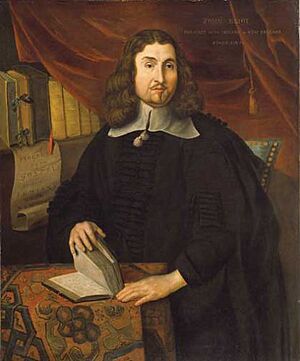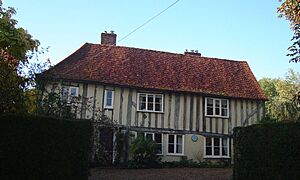John Eliot (missionary) facts for kids
Quick facts for kids
John Eliot
|
|
|---|---|
 |
|
| Born | 1604 Widford, Hertfordshire, England
|
| Died | 21 May 1690 (aged 85–86) |
| Occupation | Puritan missionary, and religious teacher to American Indians |
| Signature | |
John Eliot (around 1604 – May 21, 1690) was an important Puritan missionary in early America. He is known for his work with American Indians, especially for translating the Bible into their language. Some people called him "the apostle to the Indians." He also founded the Roxbury Latin School in the Massachusetts Bay Colony in 1645. In 1660, he finished the huge job of translating the Eliot Indian Bible into the Massachusett Indian language. More than two thousand copies were printed.
Contents
Early Life and Education
John Eliot was born in Widford, Hertfordshire, England. He grew up in Nazeing. He went to Jesus College, Cambridge for his education. After college, he worked as an assistant to Thomas Hooker at a private school. This school was in Little Baddow, England.
Later, Hooker had to leave England. Eliot then moved to Boston, Massachusetts. He sailed on a ship called the Lyon as a chaplain. He arrived in America on November 3, 1631. Soon after, Eliot became a minister at the First Church in Roxbury. He was known as a "teaching elder" there.
From 1637 to 1638, Eliot was involved in the trials of Anne Hutchinson. He did not agree with her ideas. He was one of the ministers who helped decide that she should be exiled. In 1645, Eliot started the Roxbury Latin School. He also helped edit the Bay Psalm Book. This was the first book ever printed in the British colonies in North America.
His Work in Roxbury and Dorchester
John Eliot spent most of his life in Roxbury. He was the teacher at The First Church in Roxbury for sixty years. For forty of those years, he was their only pastor. He preached in a small meetinghouse with a thatched roof.
Eliot also founded the Roxbury Grammar School. He worked hard to make sure it was successful. Sometimes, he preached in the Dorchester church too. The town of Dorchester even gave him land for his missionary work. He also shared donations he received to help the schoolmaster in Dorchester.
Translating the Massachusett Language
A big challenge for Eliot was the language barrier. He wanted to preach to the American Indians. But he couldn't use simple gestures or broken English for sermons. So, John Eliot decided to learn the Massachusett language. This was the language spoken by the local Indians.
To help him learn, Eliot worked with a young Indian man named "Cockenoe". Cockenoe had been captured in a war. He became a servant to an Englishman. Eliot said Cockenoe was the first person he used to learn words. Cockenoe could not write, but he spoke both Massachusett and English. With his help, Eliot translated important texts. These included the Ten Commandments and the Lord's Prayer.
In 1660, Eliot finished translating the entire Bible. He translated it from English into the Massachusett Indian language. It was printed by Marmaduke Johnson and Samuel Green. They used a printing press in Cambridge, Massachusetts. By 1663, they had printed 1,180 copies of the Old and New Testaments.
Eliot's first attempt to preach to Indians was not successful. But his second attempt went better. He was not the first Puritan to try converting Indians. However, he was the first to create printed books for the Algonquian Indians in their own language. This was very important. It meant that other teachers could continue his work. By translating sermons, Eliot helped Indians understand Christianity. He also helped them understand written language. They did not have their own written alphabet before this.
Missionary Work and Praying Towns

A major part of Eliot's work was converting Massachusett and other Algonquian Indians. He translated the Bible into the Massachusett language. It was published in 1663 as Mamusse Wunneetupanatamwe Up-Biblum God. This was the first full Bible printed in the Western Hemisphere. Samuel Green and Marmaduke Johnson printed 1,000 copies. They used the first printing press in the British American colonies. Native people, like Nipmuc James Printer, helped create this Bible.
In 1666, Eliot published "The Indian Grammar Begun." This book was also about the Massachusetts language. As a missionary, Eliot wanted to gather the Algonquian Indians into special towns. He hoped this would help them create a Christian society. At one point, there were 14 towns of "Praying Indians." The most famous one was in Natick, Massachusetts. Other praying towns included Littleton and Grafton. These towns were recorded by settlers like Daniel Gookin.
In 1662, Eliot saw the signing of a land deed for Mendon. This was with the Nipmuc Indians. Eliot also tried to help the Algonquian people in legal cases. He argued that the colony's goal was to help them.
Other missionaries also started praying Indian towns. However, many of these towns faced problems during King Philip's War (1675). Over time, they lost their special status. Some Native Americans were even paid to move to other areas.
Eliot also wrote a book called The Christian Commonwealth. It was about how a government should be run. He suggested a government based on the system he used with the converted Indians. This system was inspired by how Moses governed the Israelites. The book was banned in Massachusetts in 1661. All copies were ordered to be destroyed.
In 1709, a special edition of the Massachusett Bible was made. It had the Indian words in one column and English words in another. This book is also called the Massachusett Psalter.
Family Life
John Eliot married Hanna Mumford in September 1632. They had six children together: five sons and one daughter. Their daughter, Hannah Eliot, married Habbakuk Glover. One of their sons, John Eliot, Jr., became a pastor in Newton. Another son, Joseph Eliot, became a pastor in Guilford, Connecticut. Joseph's son, Jared Eliot, became a famous writer about farming. John Eliot's sister, Mary Eliot, started the Payson family in America.
Death
John Eliot died in 1690. He was 85 years old. His last words were "welcome joy!" His family became a well-known family in Boston. The historic cemetery in Roxbury, Massachusetts, is named Eliot Burying Ground after him.
Legacy
Natick remembers John Eliot with a monument. It is on the grounds of the Bacon Free Library. The John Eliot Elementary School in Needham, Massachusetts, is also named after him. It was founded in 1956.
A Puritan writer named Cotton Mather said Eliot's missionary work was a perfect example of Puritan ideals. William Carey, a famous missionary, called Eliot a hero.
In 1689, Eliot gave 75 acres of land to support the Eliot School. This school was in Roxbury's Jamaica Plain district. Eliot's gift meant the school had to accept Black and Native American students. This was very unusual for the time. The school still exists today. It continues to welcome students of all backgrounds.
The town of Eliot, Maine was named after John Eliot.
Works
- trans., The Book of Genesis, 1655.
- trans., The Psalter, 1658.
- The Christian Commonwealth: or The Civil Policy Of The Rising Kingdom of Jesus Christ, 1659 Librivox audio
- A Christian Covenanting Confession, 1660.
- trans., Wusku Wuttestamentum Nullordumun Jesus Christ (New Testament), 1661.
- trans., Mamvsse Wunneetupanatamwe Up-Biblum God (The Holy Bible containing the Old Testament and the New), 1663, rev. ed. 1685.
- The Indian Grammar Begun, 1666.
- The Logic Primer, 1672.
- The Harmony of the Gospels in the holy History of the Humiliation and Sufferings of Jesus Christ, from his Incarnation to his Death and Burial, 1678.
- Nehtuhpeh peisses ut mayut, A Primer on the Language of the Algonquian Indians, 1684.
Elliot Tracts
- New Englands First Fruits; in respect, First of the Conversion of some, Conviction of divers, Preparation of sundry of the Indians, 1643
- The Day-Breaking, if not the Sun-Rising of the Gospel with the Indians in New-England, 1647
- The Clear Sun-shine of the Gospel breaking forth upon the Indians in New-England, 1648
- The Glorious Progress of the Gospel, amongst the Indians in New England, 1649
- The Light appearing more and more towards the perfect Day, 1651
- Strength out of Weaknesse; or a Glorious Manifestation of the further Progresse of the Gospel among the Indians in New-England, 1652
- Tears of Repentance: Or, A further Narrative of the Progress of the Gospel Amongst the Indians in New-England, 1653
- A Late and Further Manifestation of the Progress of the Gospel amongst the Indians in New-England, 1655
- A further Accompt of the Progresse of the Gospel amongst the Indians in New-England and of the means used effectually to advance the same, 1659
- A further Account of the progress of the Gospel Amongst the Indians In New England, 1660
- Brief Narrative of the Progress of the Gospel amongst the Indians in New England, in the Year, 1670, 1671
See also




